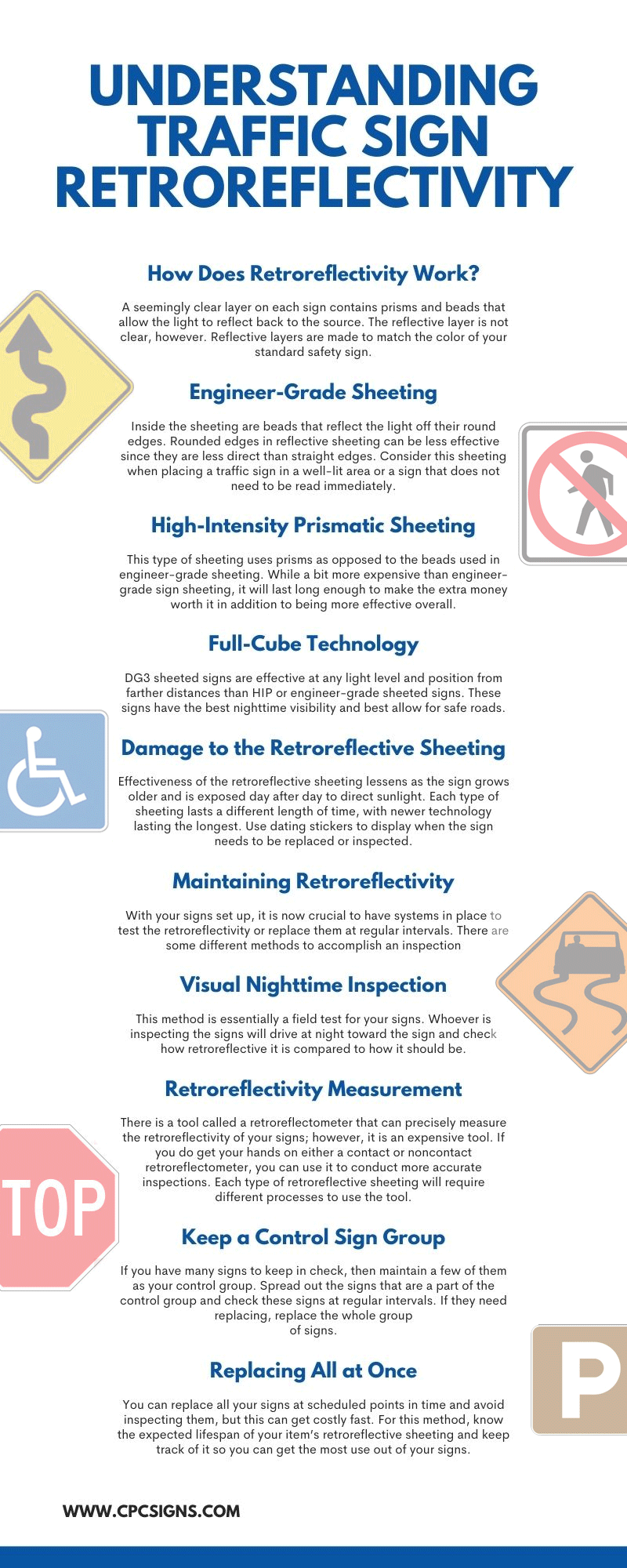How Does Retroreflectivity Work?
Retroreflectivity is the word for when traffic signs shine light from headlights back at the driver, allowing them to read any signs effectively at night or in low-light conditions. A seemingly clear layer on each sign contains prisms and beads that allow the light to reflect back to the source. The reflective layer is not clear, however. Reflective layers are made to match the color of your standard safety sign. There is a minimum retroreflectivity requirement that you must meet on every sign you place, and it varies for each sign type and type of sheeting you use, so make sure to know which type of sheeting is best for the location of the sign.
Engineer-Grade Sheeting
The cheapest kind of sheeting usually found in parking signs in nonhazardous areas is known as engineer-grade sign sheeting. The technology used in engineer-grade sheeting on signs has been used since the 1940s. It will not reflect as brightly as other sheeting types but will still work in areas where the sign does not hold as much importance. Inside the sheeting are glass beads that reflect the light off their round edges. Rounded edges in reflective sheeting can be less bright since they are less efficient than prisms. Consider this sheeting when placing a parking sign in a well-lit area. Realize, however, that engineer-grade sheeting does not last as long as newer forms of retroreflective sheeting and will need to be replaced sooner.
High-Intensity Prismatic Sheeting
Using developments in technology from the 2000s, high-intensity prismatic sheeting (HIP) from 3M™ created a brighter future for the lifespan and notice-ability of traffic signs. This type of sheeting uses prisms as opposed to the beads used in engineer-grade sheeting. While a bit more expensive than engineer-grade sign sheeting, it will last long enough to make the extra money worth it in addition to being more effective overall. HIP sign sheeting has more than five times the retroreflectivity of Type I engineer-grade sheeting and 25 percent more optical efficiency. Prism sheeting reflects light more effectively than beaded sheeting, meaning your signs will be brighter when headlights are shining on them.
Full-Cube Technology
Most recently, 3M™ developed their diamond-grade™ (DG3) sign sheeting, which has the highest retroreflectivity of all the sheeting options so far. DG3 sheeted signs are effective at any light level and position from farther distances than HIP or engineer-grade sheeted signs. These signs also allow for fluorescent colors common in many traffic safety signs available for purchase from CPC. These signs have the best nighttime visibility and best allow for safe roads.
Damage to the Retroreflective Sheeting
Effectiveness of the retroreflective sheeting lessens as the sign grows older and is exposed day after day to direct sunlight. Ensure that your traffic signs and their retroreflectivity are still working properly throughout the years. Each type of sheeting lasts a different length of time, with newer technology lasting the longest. Use dating stickers to display when the sign needs to be replaced or inspected. Check to see that your protective sheeting has a warranty in case it does not last as long as expected.
Maintaining Retroreflectivity
With your signs set up, it is now crucial to have systems in place to test the retroreflectivity or replace them at regular intervals. There are some different methods to accomplish an inspection and avoid any potential liability claims, and not all of them involve purchasing an expensive tool.
Visual Nighttime Inspection
This method is essentially a field test for your signs. Whoever is inspecting the signs will drive at night toward the sign and check how retroreflective it is compared to how it should be. The inspector should stop and park multiple times to shine their headlights at the sign from different angles. They should also be documenting everything. If the signs do not measure up to the regulated sign retroreflectivity, you must replace them.
Retroreflectivity Measurement
There is a tool called a retroreflectometer that can precisely measure the retroreflectivity of your signs; however, it is an expensive tool. If you do get your hands on either a contact or noncontact retroreflectometer, you can use it to conduct more accurate inspections. Each type of retroreflective sheeting will require different processes to use the tool. For instance, with beaded sheeting, you can point straight at a sign with a contact retroreflectometer. With prism sheeting, you must measure at a slight angle. Understanding traffic sign retroreflectivity will help you determine the best way to measure the retroreflectivity in turn.
Keep a Control Sign Group
If you have many signs to keep in check, then maintain a few of them as your control group. Spread out the signs that are a part of the control group and check these signs at regular intervals. If they need replacing, replace the whole group of signs. Keep a log of when your signs need an inspection and which signs they are. As mentioned previously, keep stickers on your signs to figure out when they need attention next.
Replacing All at Once
You can replace all your signs at scheduled points in time and avoid inspecting them, but this can get costly fast. For this method, know the expected lifespan of your item’s retroreflective sheeting and keep track of it so you can get the most use out of your signs.
Retroreflectivity can be a difficult concept to grasp when considering the parts of a sign, but when you’re buying from a certified company such as CPC, you are in good hands. Be careful when buying from companies that may have prices that are too good to be true—they might lack the mandatory retroreflectivity required to keep drivers safe at night. Remember, brighter signs mean safer roads.






